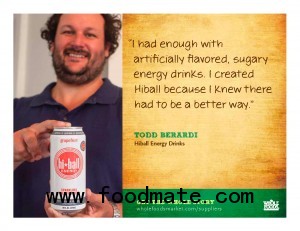
The brand, for years an unsweetened, essence-flavored “energy water” packaged in 11.5 oz. glass bottles, had carved out a small niche in grocery and at Whole Foods, but a risky decision to change the packaging has attracted lots of attention – and several important new retail accounts.
“It’s taken a lot longer than we’ve thought,” said co-founder Todd Berardi, “But people are waking up to the idea that we have a healthy energy drink, the only one without calories, sugar, sweeteners of any kind. It’s all-natural, it’s naturally zero calorie, and when you taste the product, we’re clearly different.”
But for a while, when it was packaged in glass, the brand may have been too different for many grocery buyer tastes. Since moving into the 16 oz. can style that is more typical of the energy drink category, however, the brand has received not just increased attention from Whole Foods, but also nationwide approval in Kroger for all six of its SKUs (four zero-calorie energy waters and two 100-calorie juice blends), as well as accounts in Ralph’s, Wegman’s, Jewel-Osco and many others.
That’s not to say that the product doesn’t remain different: While Hiball adopted a more conventional profile by moving into cans, it maintained its innovative edge with the cold-activated paint – and also succeeded in “greening” itself a bit further by moving to an energy blend derived from organic sources of guarana, caffeine, and ginseng.
“We loved glass, but it wasn’t easily merchandised next to cans or easy for people to understand what the product was at first glance,” Berardi said. “What I had to overcome personally, as the founder, was to accept that what we were selling inside the package was unique and healthier. We realize now with the traction that we’re getting, it’s the same product with organic ingredients, but when you put it in a higher velocity accepted package of the category with a premium design, it’s starting to take off.”
Hiball’s core retailer account, Whole Foods, has carried the brand on a national basis for several years (except for Florida and the mid-Atlantic, where it’s been in-and-out) but the new package has the retailer showing some genuine love via its featured supplier promotional program.
Hiball is currently featured in Whole Foods’ newsletter, as well as its “Whole Story” blog. Even more important, in-aisle displays now show the burly San Franciscan holding a can, telling customers “I had enough with artificially flavored, sugary energy drinks. I created Hiball because I knew there had to be a better way.”
Promotional copy aside, the company had grown slowly over its five-year history, and the brand’s truly better way to bring on retailers didn’t start until the move to the can. The more conventional package opened some eyes, and attracted potential investors – Berardi says he hasn’t taken any on yet — as well as a partnership with L.A. Libations to help open new accounts on behalf of the product.
“From my lens, it was almost too different from where the category is,” said L.A. Libations co-founder Danny Stepper. “Now, there’s no need to go to great lengths educating the consumer.”
The brand has a long-term deal with L.A. Libations to harness the company’s deep relationships with retail buyers to help boost volumes. While questions concerning equity were greeted without comment, Stepper did allow that “our interests are completely aligned for the long term growth of the brand.”
Meanwhile, Berardi has his own long-term growth issues: he and his wife recently had twins, Gunnar and Kaia. Word is that their packaging is largely conventional.





